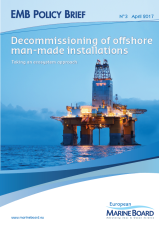
We are entering a legacy era for the offshore oil and gas industry. As operations ramp down, could scientific evidence hold the key to reducing economic cost and environmental impact of full decommissioning?
This Policy Brief assesses the role of marine science in reducing the environmental impact of decommissioning and highlights the scientific questions that now need to be answered to settle the debate on what should be done with these structures. Recent estimates suggest that there are currently around 1,350 oil and gas installations in the North Sea and North Atlantic regions and 1,800 offshore wind turbines in North Sea region alone. And this number is rising. The total cost of full decommissioning of oil and gas installations in the North Sea alone for the period 2015 to 2040 is estimated at between US$70 and US$82 billion. The numbers of installations requiring decommissioning is also set to increase dramatically as renewable energy devices begin reaching the end of their operational life, and as plans for exploiting renewable energy sources in the near future grow. Globally, industry and governments are embracing different decommissioning approaches, from full removal to the production of artificial reefs. The question of what is best for the environment is still to be answered.
The INSITE programme, highlighted in this Policy Brief as novel model which could be implemented more widely, is a unique collaboration between leading energy companies and research. It is already funding research which is exploring the influence of man-made structures on the marine ecosystem in order to provide a solid scientific basis for future decision-making.
Ultimately, appropriate decisions need to be made in the very near future regarding the decommissioning of oil and gas and renewable energy structures. At present, there remains a need for more scientific research to better inform the decision-making process regarding their fate.
A short fact sheet relating to this publication, intended for policy makers, can be found here. You can find the news release for this document here, and the related news article here.
EMB tracks the dissemination and impact of its documents for at least 2 years after publication. You can find a short summary of the dissemination and impact of this policy brief here.